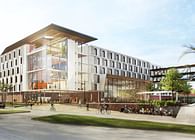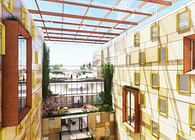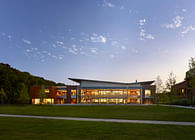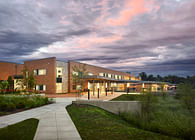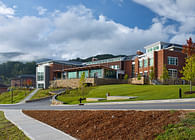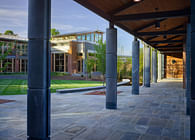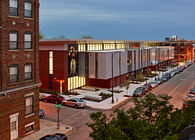
Charlottesville, VA | Washington, DC
Nicknamed “the Friendly City,” Harrisonburg, Virginia is a designated refugee resettlement community experiencing tremendous growth: over 35% of Harrisonburg City Public School (HCPS) students identify as English Language Learners, representing over 60 countries and speaking 58 languages. Guiding principles of Bluestone Elementary School’s design include celebrating this amazing diversity, fostering a sense of inclusion, and offering flexible learning opportunities in a net-zero energy ready environment that can evolve and expand with the school community.
Celebrating diversity began with designing around the needs of the school’s teachers and students. During the planning process, educators expressed a desire for team teaching and the need for flexibility in learning spaces. The resulting design is comprised of 42 core learning studios organized into grade-level neighborhoods. Learning studios provide a variety of flexible scales and arrangements, allowing educators to easily configure their spaces into small groups or take full advantage of team-teaching through combined classrooms. Extended learning areas are distributed throughout the neighborhood to empower one-on-one collaborations that complement the project-based work occurring in studios.
The school places special emphasis on inclusion and community-building in a diverse setting and celebrates the cross-section of cultures represented in the school population with an interactive flag wall near the lobby. Place-based wayfinding and environmental graphics give identity to each neighborhood, building comradery within learning communities. Visual connections throughout the building, as well as to the landscape beyond, help to orient students and connect them to the unique beauty of the Shenandoah Valley. Modeled after a “garden patch” serving model, the Dining Commons is visually and physically connected to outdoor raised beds, learning gardens, and a variety of nature-based play spaces designed to incentivize healthy eating and activity.
The school’s three stories maximize site area for play and outdoor learning. The compact form and thoughtfully-designed building envelope are key factors in the building’s energy use intensity of 17.8 (EUI). Extending from the four main entry areas are patios, terraces, learning meadows, and outdoor classrooms carved out of the site’s topography. Boulders and trees harvested during construction are re-purposed as natural play features and paired with native grasses, trees, and wildflowers that reveal visible water conservation and stormwater management.
Similar to the learning neighborhoods inside, outdoor learning spaces emphasize a variety of scales, allowing for a diversity of programming and community events year-round. Named the "most livable building" by the Center for the Built Environment, the school celebrates diversity of people, place, and program while creating a singular feeling of home that contributes to occupant health and happiness.
Status: Built
Location: Harrisonburg, VA, US
Firm Role: Architect of Record
Additional Credits: Photography by Lincoln Barbour and Alan Karchmer
